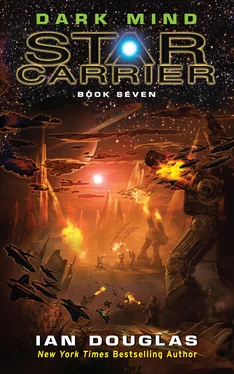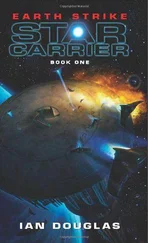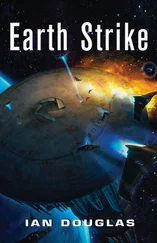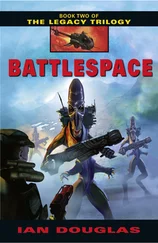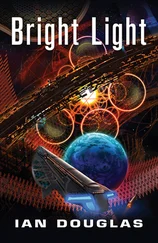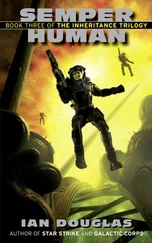Fighter pilots called it threading a needle … a reasonable analogy. The interior opening of a TRGA was only slightly wider than America was long. Still, within the TRGA’s lumen, minute variations in position and velocity created wildly different pathways through space and time. The ships of the America battlegroup were following a carefully programmed and precise series of maneuvers as they entered the spinning maw.
“Okay, people,” Gray said softly. “All nav systems to automatic. Let the AIs take us through.”
The warning was unnecessary—more nervous reassurance than anything else. All twelve ships of Battlegroup America were being guided now by powerful artificial intelligences. Presumably, the additional ship, the Glothr Nameless , was guided by non-organic systems as well. Jellyware brains—even enhanced by AI implants—simply weren’t precise enough or fast enough to handle the variables successfully.
For a breathless moment, the star carrier America hung on the verge between one space and another …
And then unimaginable energies seized the vessel and dragged her in.
Lieutenant Donald Gregory
VFA-96, Black Demons
0458 hours, TFT
Something strange was happening to time.
The TRGA was just twelve kilometers long. Traveling at some twenty kilometers per second relative to the alien portal, Gregory should have been through and out the other side in six tenths of a second. It felt , however, like ten or fifteen seconds, an impossibly long time as the blurred gray walls of the tube swept past his ship, terrifyingly close. The slightest miscalculation, and his fighter would be shredded by contact with a wall moving at very close to c . Even if he didn’t hit that motion-smeared surface, a tenmeter drift in any direction would put him on a different spacetime trajectory … and the gods alone knew where he would emerge … or when.
Then the TRGA’s walls vanished, whisked away at twenty kps as Gregory’s fighter emerged into open space once more.
And this new space was extraordinarily crowded with stars.
“My God …” he breathed, awed. The White Covenant be damned—the phrase spoke to how he felt.
The Black Demons were moving through the central core of the N’gai star cluster … a dwarf galaxy just above the plane of the vast spiral of the Milky Way. The TRGA had brought them back through time as well—some 876 million years into their remote past. In this epoch, life on Earth was still confined to the planet’s seas and was only just then discovering that sex and genetic diversity were useful evolutionary ideas.
“Commsat away,” Mackey reported. The satellite would drift in front of the TRGA, recording all transmissions from the squadron. If anything happened to the fighters …
Gregory didn’t allow himself to think about that.
“We have company, Skipper,” he reported. “Bearing zero-zero-five, minus two-one, range three-zero-thousand.”
“Got it, Greg. All Demons, shift vector to zero-zero-five, minus two-one. Do not, repeat do not initiate hostilities …”
“Not unless they freakin’ initiate first,” Kemper added.
Gregory could see the oncoming alien spacecraft in an in-head display, picked up by his fighter’s long-range optics, magnified, and streamed through the craft’s AI into his brain. They were small, each only a meter or two across. They were oddly shaped, too, no two precisely alike. Perhaps more important, there were thousands of them in an onrushing cloud.
It did not look like a friendly reception.
And something was happening within that cloud of oncoming craft. Individual ships were shifting position, orienting themselves as though seeking to form some larger structure. Within his in-head, Gregory could see a series of rings, perfectly aligned, each a hundred meters across.
What the hell?
“Thirty thousand kilometers,” Mackey said. “We need to get …”
“ Hostile incoming! ” Lieutenant Cynthia DeHaviland yelled over the tactical link. “ The bastards are firing! ”
A tightly coherent bolt of energy struck Demon Six—Lieutenant Voight’s ship. The Starblade vanished in a cloud of white-hot vapor.
“Spread out and accelerate!” Mackey ordered. “Boost to five hundred Gs! Let’s close the gap!”
The eleven surviving Starblades hurtled forward, their velocity increasing by five kilometers per second each second. Ahead, the cloud of silvery objects continued to maneuver to organize themselves into a huge, indistinct structure. The energy bolt had come through those closely aligned rings, and Gregory’s long-range scanners were picking up evidence of a fast-building magnetic charge …
“It’s a particle cannon!” Gregory called as understanding gelled. “It’s a fucking particle cannon five kilometers long!”
Gregory wondered how they’d managed that trick … positioning individual spacecraft like pieces in a titanic puzzle, not touching physically, but apparently locked together by magnetic fields. He didn’t ponder it long, as another pulse of energy surged up through the floating rings and very nearly caught Lieutenant Caswell, who rolled clear just as the particle beam passed him.
“Spread out, damn it, spread out !” Mackey yelled. “Arm Kraits! Target the dense parts of that cloud!”
Each Starblade carried a full complement of thirty-two VG-92 Krait space-to-space missiles, plus six of the massive and more powerful VG-120 Boomslangs. Still, a total of 418 missiles of varying megatonnage, Gregory reflected, was not going to go very far against that vast and sprawling cloud of diminutive alien vessels.
They would have to make each shot count, taking great care in the placement of every one. By targeting the thickest regions of the alien spacecraft cloud, they would do the greatest damage with what they had available.
I hope.
“Fire!”
Gregory had already brought up the control icons for the first two Kraits in his magazine, arming both and setting their yields to a hundred megatons each. The alien swarm dominated an in-head window; he zoomed in on a dense knot of alien vessels—a part of the open architecture of the enemy’s immense particle cannon.
“Demon Four, Fox One!” he yelled over the tactical channel. “Times two!”
Centuries before, the “Fox One” radio call had meant the launch of a heat-seeking missile. Now it meant a smart missile like the VG-92 Krait shipkiller, the Boomslang, or Fer-de-lance … or even the old-style Kraits, the VG-10s, now obsolete and considerably less competent in the AI department.
With his first two shots away, Gregory shifted targets, brought two more Kraits on-line, and loosed them. His primary tactical display was fast becoming an indecipherable mass of fighters, targets, and the slow-crawling contrails of missiles in flight. All of those contrails swung wide before angling in toward their targets, and their onboard AIs had them dodging and twisting to avoid enemy defensive fire, turning the display into a classic dogfighting furball. His AI could read the mess though, even if he could not. This allowed Gregory to focus his attention on maneuvering the Starblade, trying to make sure that it was not where the enemy was aiming and firing that colossal particle gun—
—which fired again, an instant before the first Kraits detonated in silent blossoms of white light … one blast after another, each equivalent to 100 million tons of high explosive.
Alien ships evaporated by the hundreds, caught between multiple expanding plasma shock waves and by intense bursts of electromagnetic radiation. Nuclear explosions were not nearly as effective in the vacuum of space as they were in an atmosphere, but the temperature at the heart of each blast still measured well over 100 million degrees. As the fireballs faded, large bubbles of emptiness were stitched through the mass of silvery spacecraft. The precise organization of the particle gun appeared to have been disrupted, and the remaining fragments of the structure dissolved as alien spacecraft abandoned it.
Читать дальше
